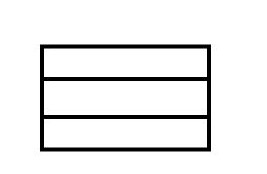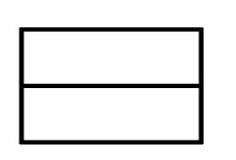
Draw a prism with its base as a regular hexagon with one of its edge facing you. Now draw the top view, front view and side view of this solid.
Answer
569.1k+ views
Hint: This question is based on the projection of a solid. In this question we have to draw a prism having its base as a regular hexagon and then using the First Angle Projection method we have to draw the top view, front view and side view of the prism. In the First Angle Projection the object is always placed in the first quadrant.
A regular hexagonal prism has a total of 8 faces (6 faces are rectangular and 2 faces are hexagons), 18 edges, and 12 vertices.
Complete step-by-step answer:
Given:
First, we draw the prism with its base as a regular hexagon with one of its edge facing the observer. The step by step construction is given below-
i) Since no specific dimensions of its sides are given then choose any length and construct a hexagon with one of its sides lying flat in the horizontal plane. The easy method to draw a hexagon is by using the protractor and making an angle of 120 degrees.
ii) Now draw another hexagonal with the same method as above at some distance from the first hexagon. This distance would be the height of the hexagon.
iii) Now join all the points of one hexagon with their similar points on the other hexagon using a simple ruler scale.
This is how the prism with its base as a regular hexagon with one of its edge facing the observer will look like-

Now using the above drawing of the hexagonal prism, we derive its top view, front view and side view according to the First Angle Projection method.
The top view of this prism will look like a Rectangle. The drawing representation of the top view is given below-

The front view of this prism will look like a Hexagon. The drawing representation of the front view is given below-

The side view of this prism will also look like a Rectangle. The drawing representation of the side view is given below-

Note: It should be noted that all the views are derived from the first drawing of the hexagonal prism. Which means that the dimensions of the all the views are the same as the first drawing of the prism, there is no difference in the value of the length or angle of the sides.
A regular hexagonal prism has a total of 8 faces (6 faces are rectangular and 2 faces are hexagons), 18 edges, and 12 vertices.
Complete step-by-step answer:
Given:
First, we draw the prism with its base as a regular hexagon with one of its edge facing the observer. The step by step construction is given below-
i) Since no specific dimensions of its sides are given then choose any length and construct a hexagon with one of its sides lying flat in the horizontal plane. The easy method to draw a hexagon is by using the protractor and making an angle of 120 degrees.
ii) Now draw another hexagonal with the same method as above at some distance from the first hexagon. This distance would be the height of the hexagon.
iii) Now join all the points of one hexagon with their similar points on the other hexagon using a simple ruler scale.
This is how the prism with its base as a regular hexagon with one of its edge facing the observer will look like-

Now using the above drawing of the hexagonal prism, we derive its top view, front view and side view according to the First Angle Projection method.
The top view of this prism will look like a Rectangle. The drawing representation of the top view is given below-

The front view of this prism will look like a Hexagon. The drawing representation of the front view is given below-

The side view of this prism will also look like a Rectangle. The drawing representation of the side view is given below-

Note: It should be noted that all the views are derived from the first drawing of the hexagonal prism. Which means that the dimensions of the all the views are the same as the first drawing of the prism, there is no difference in the value of the length or angle of the sides.
Recently Updated Pages
Master Class 9 General Knowledge: Engaging Questions & Answers for Success

Master Class 9 English: Engaging Questions & Answers for Success

Master Class 9 Science: Engaging Questions & Answers for Success

Class 9 Question and Answer - Your Ultimate Solutions Guide

Master Class 12 Economics: Engaging Questions & Answers for Success

Master Class 12 Maths: Engaging Questions & Answers for Success

Trending doubts
Which places in India experience sunrise first and class 9 social science CBSE

Fill the blanks with the suitable prepositions 1 The class 9 english CBSE

Write the 6 fundamental rights of India and explain in detail

Difference Between Plant Cell and Animal Cell

What is pollution? How many types of pollution? Define it

What is the Full Form of ISI and RAW




